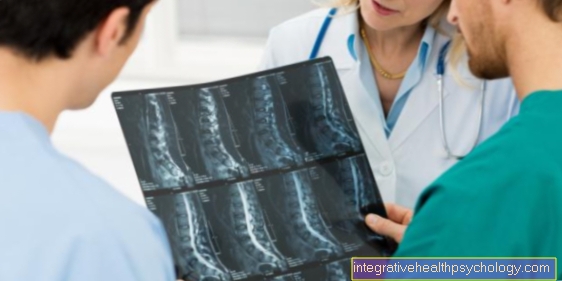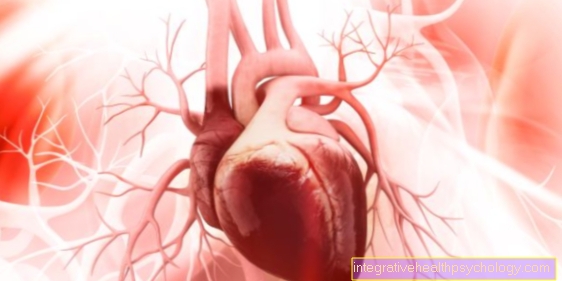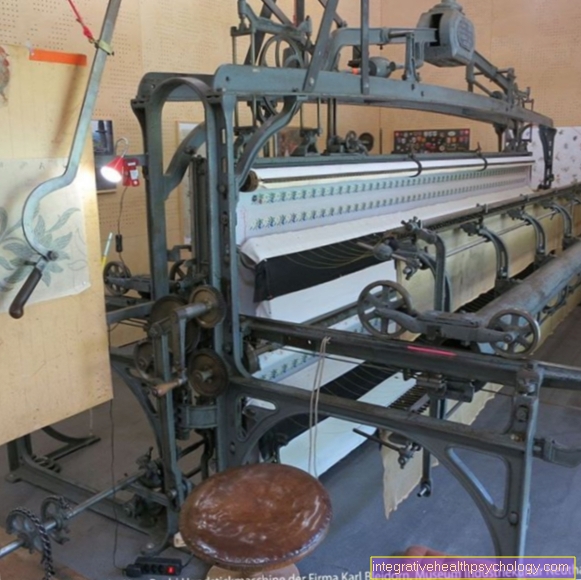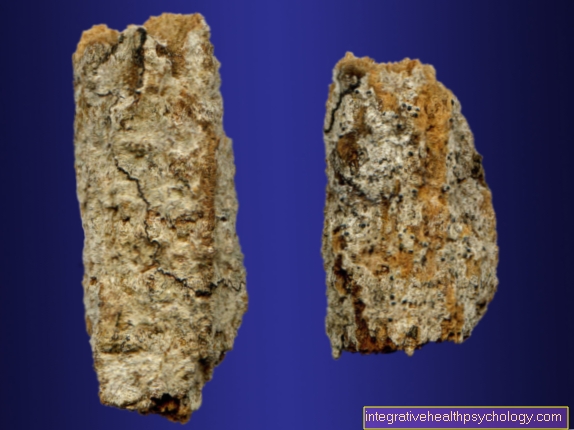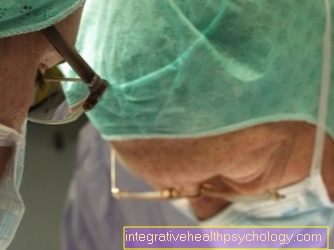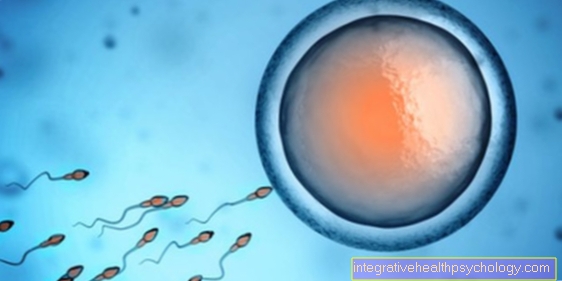Pain under the ribs when breathing
Definition - What is pain when breathing under the ribs?
Pain under the ribs is often characterized by its appearance depending on the breath. In most cases, the pain becomes worse when you breathe in, as this increases the pressure in your chest. When you exhale, on the other hand, the pain improves in most cases. Shallow breathing should also improve the symptoms. The term “under the ribs” can be understood in two ways. On the one hand, it can mean the localization within the chest, so to speak behind the ribs, on the other hand, pain under the ribs can also be at the transition to the abdominal cavity.

Causes of painful breathing under the ribs
Basically, all structures in the body that are above, below, behind and between the ribs can cause pain when breathing under the ribs. The most serious causes are found in the organs that lie within the rib cage. For example, diseases of the lungs, heart, and esophagus can cause pain under the ribs when breathing. Less worrying diseases that can cause pain when breathing mostly affect the muscles (diaphragm, intercostal muscles, back muscles) and the bones (spine, ribs) or the nerves that run from the spine along the ribs to the chest.
These can be major causes of the pain under the ribs when breathing:
- Intercostal neuralgia
- Rib block
- Diaphragmatic pain
- Heart attack
- Pulmonary embolism
You will be informed about this below.
Intercostal neuralgia - chest pain caused by nerves
Intercostal neuralgia (inter = between, costa = rib, neuron = nerve, -algia = ending for a state of pain) refers to pain emanating from the nerves that run between the ribs. Often the reason is an entrapment of the nerve between the rib muscles and a rib. A constriction of the nerve at the point of exit from the spinal cord can also be the cause of the symptoms. Because the intercostal neurons (nerves between the ribs) run along the rib, the movements of the chest when you breathe move them too. If an area becomes trapped, the nerve is stretched with every breath. This manifests itself in sometimes stabbing, pulling or electrifying pain when breathing under the ribs.
For more information on intercostal neuralgia, see: Chest pain from nerves
Rib block
Each of the twelve ribs of the chest is connected to the spine by a joint, ribs 1 to 7 are connected to the sternum by a second joint. A rib block is characterized by immobility in these joints. In most cases, the joints between the ribs and the spine are affected. In older people, signs of wear and tear are usually the cause of the symptoms, but it can also be caused by an injury and acute trauma. When you breathe, the ribs move in their joints, so if you have a rib block, you will experience breath-dependent pain.
Further information on this topic can be found at: These are the symptoms you can tell if you have a rib block
Diaphragmatic pain
The diaphragm is the most important respiratory muscle in the human body. At the same time, it serves as an anatomical boundary between the chest cavity and the abdominal cavity. By tensing the diaphragm, the space in the chest increases so that air can be inhaled. The relaxation pushes air out of the lungs again. If the diaphragm is damaged, this can cause discomfort, especially when it is tense (i.e. during the inhalation phase). It is believed, for example, that stitches in the side during exercise have to do with overloading the diaphragm. Injuries to the diaphragm can also cause pain under the ribs when breathing.
For more information, we recommend our website to: Pain in the diaphragm
Pulmonary embolism
Pulmonary embolism can be acutely life-threatening. In this disease, one or more blood clots form, which can lodge in the vessels of the lungs, block them and thus increase the resistance in the lungs. Depending on how many vessels in the lungs are affected and how large these vessels are, symptoms can vary. Characteristic symptoms of a pulmonary embolism are acute shortness of breath and breath-dependent chest pain.
Further information on this topic can be found at: Pulmonary Embolism Symptoms
Heart attack
A heart attack is an acutely life-threatening condition. Reduced blood flow (and thus insufficient supply of oxygen and other nutrients) leads to damage to the heart muscles. This is noticeable in the form of severe pain combined with a feeling of pressure and tightness on the chest. The pain of a heart attack is not dependent on the breath, but is often perceived as such by those affected, as the feeling of pressure on the chest is increased when inhaling.
Also read: Signs of a heart attack
Other accompanying symptoms
Depending on the cause of the pain when breathing under the ribs, other accompanying symptoms may also occur. In most cases, pain is relieved by breathing shallowly and increased by breathing more, such as during exercise. Often other pain is associated with the symptoms, such as pain in other parts of the chest or on the back and in the abdomen. In addition, the pain is often not only breath-dependent, but can also be triggered by various movements of the upper body, i.e. movement-dependent.
In the case of acute injuries in the chest area, external bleeding or hematomas (bruises) can also occur. In pulmonary embolism and heart attack, there is often not only breathing-dependent chest pain but also shortness of breath. This is particularly intensified by stress. With a heart attack, there is usually a pressure or tightness on the chest. In the worst case scenario, both diseases can result in loss of consciousness and life-threatening cardiac arrest.
Also read:
- Pain in the back when breathing
- Pain on inhalation right
- Pain in the left side when inhaling
Treatment of chest pain
The therapy for chest pain must be made dependent on the underlying cause. In the case of muscular problems, physical rest is sufficient in most cases until the muscles have recovered. If necessary, relaxation exercises can improve the symptoms. If the pain is so severe that it interferes with breathing, pain relievers should be taken until the symptoms improve.
In most cases, intercostal neuralgia can also be treated conservatively; the pinched nerve rarely has to be released from the ribs with a firm pull. If the intercostal neuralgia is associated with major damage to the spine, surgical therapy may also be necessary.
Diseases such as pulmonary embolism and myocardial infarction usually first require stabilizing intensive medical therapy. Then the cause can be eliminated, for example by dissolving the blood clot in the lungs with blood thinners. In the event of a heart attack, a stent (wire mesh) usually has to be placed in the coronary arteries. This small wire mesh can reopen the blocked vessels and thus ensure better blood flow to the heart muscles.
Duration and prognosis of breath-dependent pain
The duration of the breath-dependent pain depends heavily on the cause. Muscular and bony complaints can usually heal completely after a few weeks, while organic diseases take a long time to heal and can also become chronic problems. Most of the causes of painful breathing under the ribs are harmless and completely heal. Dangerous causes such as pulmonary embolism and myocardial infarction can be acutely life-threatening and often have a life-shortening effect - even with good care.
Correct diagnosis of pain when breathing under the ribs
The most important step in finding the cause of the pain when breathing under the ribs is based on the patient interview (anamnesis). The doctor will ask about the severity and duration of the pain. Only in this way can a targeted diagnosis of the symptoms follow. Depending on the suspected cause, the heart, lungs, bones, and muscles of the chest should then be examined in detail. If necessary, X-ray or ultrasound imaging is carried out. In the case of a suspected pulmonary embolism or a heart attack, laboratory parameters from a blood sample can also provide important information, and an ECG should also be performed.

